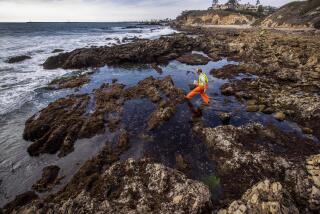Should Ship Sanitation Issue Be Dry-Docked?
- Share via
A doctor friend we met on a cruise ship, knowing our interest in shipboard sanitation, sent us a clipping on the subject from the March 21 issue of American Medical News.
The article praised the tough inspection standards of the U.S. Public Health Service Centers for Disease Control on foreign-flag vessels that call even occasionally at an American port. It also pointed out that “both the CDC and the cruise industry believe the need for vigilance remains.”
That clipping was filed beside a late January report from a travel-industry publication that raised the question of whether travel agents should be responsible for advising cruise clients if that ship had failed to pass its most recent public health inspection.
Then, at the end of March, the semiweekly blue summary sheet from the public health service brought the latest news, that routine inspections were being discontinued in favor of a restructured program that called for the CDC to “work with the industry to initiate a self-inspection program, which the industry can carry out on its own.”
Policing Itself
(Each cruise line spokesman we asked about it assured us that while his line was capable of policing itself, he wasn’t so sure about some of the others.)
Under the restructured program, according to John C. Yashuk, chief of vessel sanitation control activity in Miami, only those vessels that are new, old ships coming for the first time to a U.S. port or ships that have experienced outbreaks of gastrointestinal illness affecting more than 3% of their passengers are inspected. Those results will be reported and available for three months after the inspection.
A self-inspection manual has been developed by the CDC and sent out to cruise lines, while some former inspectors have offered a private inspection and consultation service to the cruise lines.
The first results from the restructured program were published in the semimonthly blue card summary for Aug. 4. Subscribers learned that Carnival’s Holiday and Holland America’s Rotterdam had both reported a number of gastrointestinal outbreaks during a particular month this spring (a result, one of the lines said later, of a virus that was going around South Florida at the time). Also, that Epirotiki’s Jason and Regency’s Regent Sea, both new to U.S. ports, did not meet sanitation standards on their first inspections.
Yashuk said the department has received letters from the public protesting the cessation of the full inspection program, but added that the program had been in effect for almost 11 years and that “the cruise lines should be able to inspect themselves.”
Under the new system, no provisions are made for follow-up inspections on ships that fail. “If it fails, the company is responsible for correcting it,” Yashuk says. Detailed inspection reports on individual vessels will be available for only three months after an inspection. (You may obtain a free copy of the report on one ship only by requesting it from Sanitation & Vector Control Activity, Division of Quarantine, 1015 North American Way, Room 107, Miami, Fla. 33132.)
Failed Ships Listed
The final full report, issued May 9, listed 67 ships that had been routinely inspected, of which 28, nearly 42%, failed to meet CDC sanitation standards.
Given even certain structural flaws that occur in some older ships, this is still alarmingly high from a passenger health standpoint.
Last year was probably the CDC’s most productive year in the past decade. The May final report covered 22 more ships than a previous summary we wrote about in October, 1984, when 20 out of 45, or 44%, failed. In 1975, the first year under the present guidelines, not a single ship out of the 60 inspected was able to pass muster.
While the CDC has never had the legislative authority to implement sanctions against foreign flag cruise ships, it can recommend that a ship with an excessive number of sanitation violations not sail from a U.S. port with passengers on board, which they have done several times.
Yashuk would not comment on whether or not his program is a victim of recent federal budget cuts. Nevertheless, a travel industry publication earlier this year quotes him in pointing out that about 40% of ships inspected in the previous six to eight months had failed to earn a passing mark, and that the average failure rate recently slipped from around 25% to 30% of all ships inspected.
This would seem to be at odds with the assumption that the industry is ready to police itself if, after more than 10 years, a higher percentage of ships is failing than before.
By the same token, it’s idealistic to expect some cruise lines to continue carrying their own sanitation officers on board, remodeling out-of-date galleys or hiring outside inspection firms while other companies simply ignore the whole thing.
Some Kind of Watchdog
The situation seems to call for some kind of watchdog to check on shipboard sanitation practices. Otherwise, the only way we’re going to know something is wrong is when more than 36 passengers on a 1,200-passenger ship come down with a gastrointestinal illness.
And for those 36 people who have had their dream vacation spoiled, that’s a little late.
More to Read
Sign up for The Wild
We’ll help you find the best places to hike, bike and run, as well as the perfect silent spots for meditation and yoga.
You may occasionally receive promotional content from the Los Angeles Times.






